A story of artistry — and Terry Austin’s generosity.

—
UPDATED 8/23/19: Inker Terry Austin turns 67! Since he figures so prominently in this piece, which first ran in February 2018, it’s the perfect time to re-present it. And for a 13 COVERS birthday salute to Austin, click here. Enjoy. — Dan
—
In January 2018, I posted our annual celebration of the late, great Marshall Rogers, timed to his birthday. (Click here. You’ll be glad you did.) Central to the salute was a look at Rogers’ rare Batman newspaper strip, a piece that was inspired by a care package sent to me by 13th Dimension reader Bill DeSimone. (Click here. Cool stuff.)
Well, it turns out Bill has one helluva story to tell about Marshall Rogers’ art — and the thoughtful generosity of his top-flight inker, Terry Austin. I’ve invited him to tell it here. Read on. — Dan
—
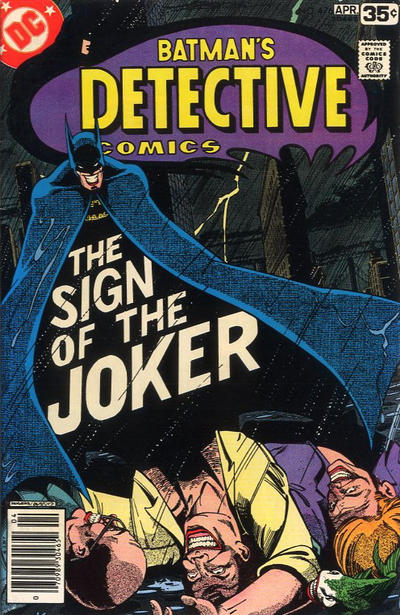
Rogers and Austin
By BILL DeSIMONE
My favorite page of Marshall Rogers’ art comes from the last issue of the Steve Englehart run (Detective #476, Page 14), the climax of their Joker story.
Batman has chased the Joker across fire escapes, over rooftops, to a building under construction. They’re both high up in the girders when the Joker sprays acid at Batman, bringing us to the page in question.
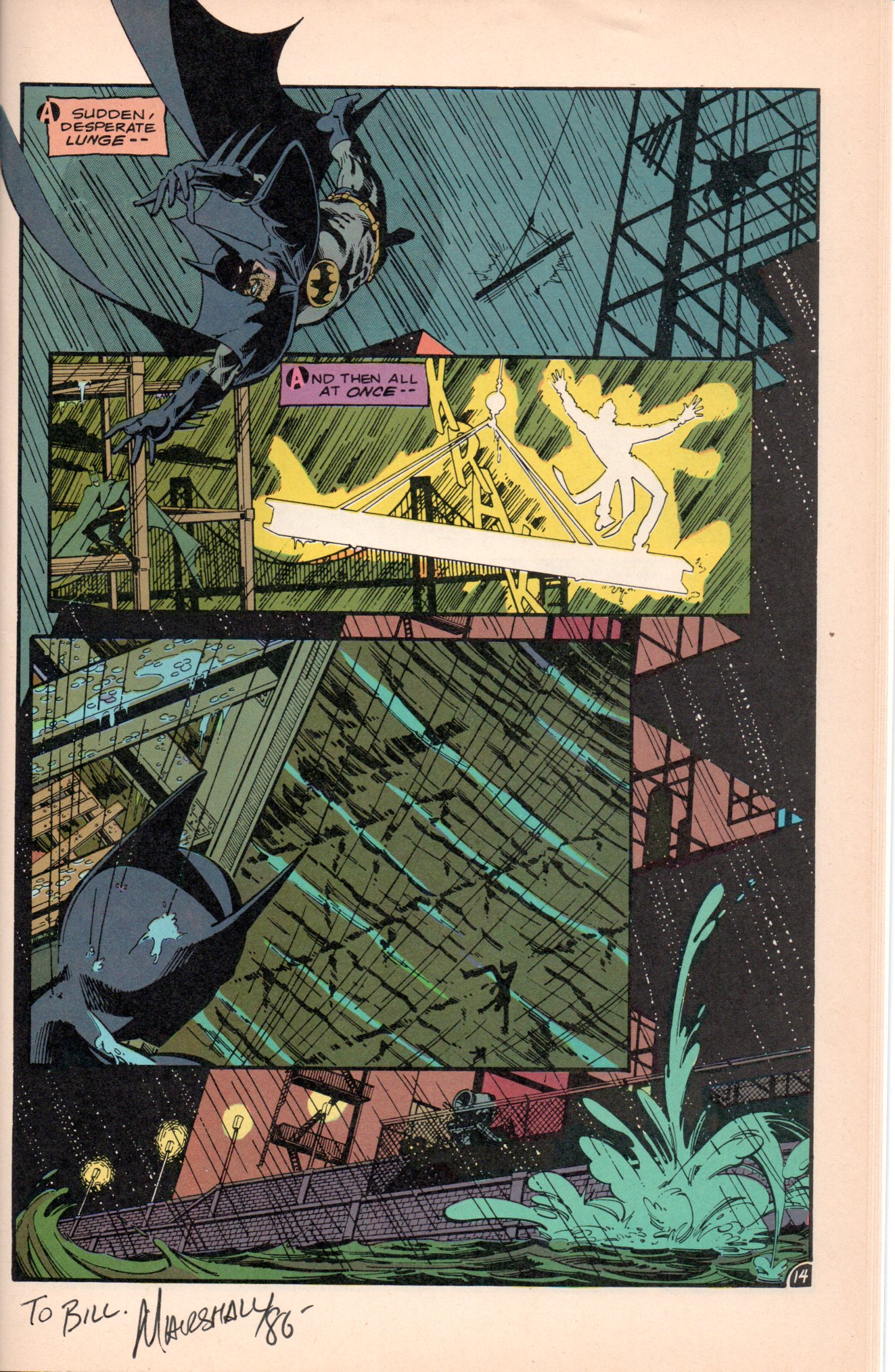
Now, in reading conventional comics, your eyes go to the top tier of a page, you read left to right, next tier down, left-right, and so on. On this page, Rogers completely disrupts that flow, but all the cues of where to look next are in the visuals:
At the top left, Batman makes “a sudden desperate lunge” away from the acid. Instead of the next action happening on the top right, his body is diving toward the left. You follow the direction of his dive and now Rogers pulls his camera back, so you see the Batman standing safely on a girder. In the background is the silhouette of a bridge, which you follow directly to the right. The bridge stays in the background; in the foreground you see lightning strike the Joker.
The girder the Joker stands on is attached to a cable; follow the cable to the upper right, and Rogers pulls the camera back again, with an upward angle. You see the silhouette of the Batman, and the girder that the Joker just fell off, wobbling in the rain. Follow the direction that Batman is looking, down to the lower left, and Rogers swings the camera angle again to above and behind Batman, watching with him as the Joker falls to the water. Follow the Joker’s fall, and the last image on the page is the splash of Joker hitting the water.
Notice, there are really only four panels on this page: Top left, “Sudden, desperate lunge—.” The small, horizontal rectangle with Batman, the bridge, the lightning and the Joker. The larger rectangle, with Batman watching Joker fall. And the biggest panel is the actual page, as the splash is the same panel as the top right.
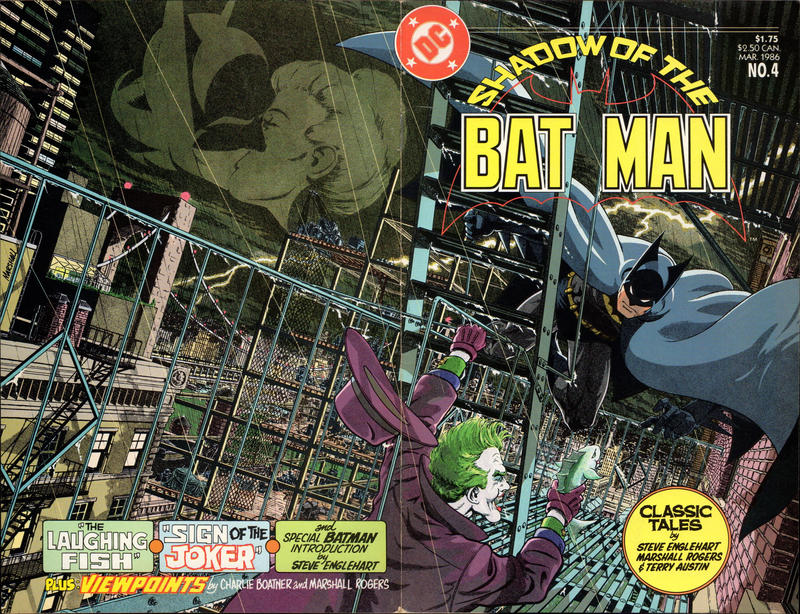
The scan here is actually from the Shadow of the Batman reprint from 1985, signed by Rogers at a con in 1986. When I mentioned the above to him, he said, “yep.” I jotted down some notes at the time, and he also said: “Comics must get more visually attractive to compete with other forms of entertainment. Six panels a page, a different scene each panel: what worked when comics started was successful because people rarely saw television or movies… the success of Simonson’s Manhunter showed me there was a place for the kind of comics I wanted to do.”
Another note about this. After the Keaton Batman movie, the Museum of Cartoon Art in Rye, N.Y. (since relocated) had a big Batman event. Keaton’s costume was there, batarangs, comics, original art, etc. I noticed a few pages of the Rogers/Austin art from this run were there, but not this page.
Not long after, I met Terry Austin at a con. I asked about the page and if he was interested in selling. He didn’t remember but said he’d check. A few weeks later, I got this oversized envelope in the mail, clearly with Austin’s handwriting on it:
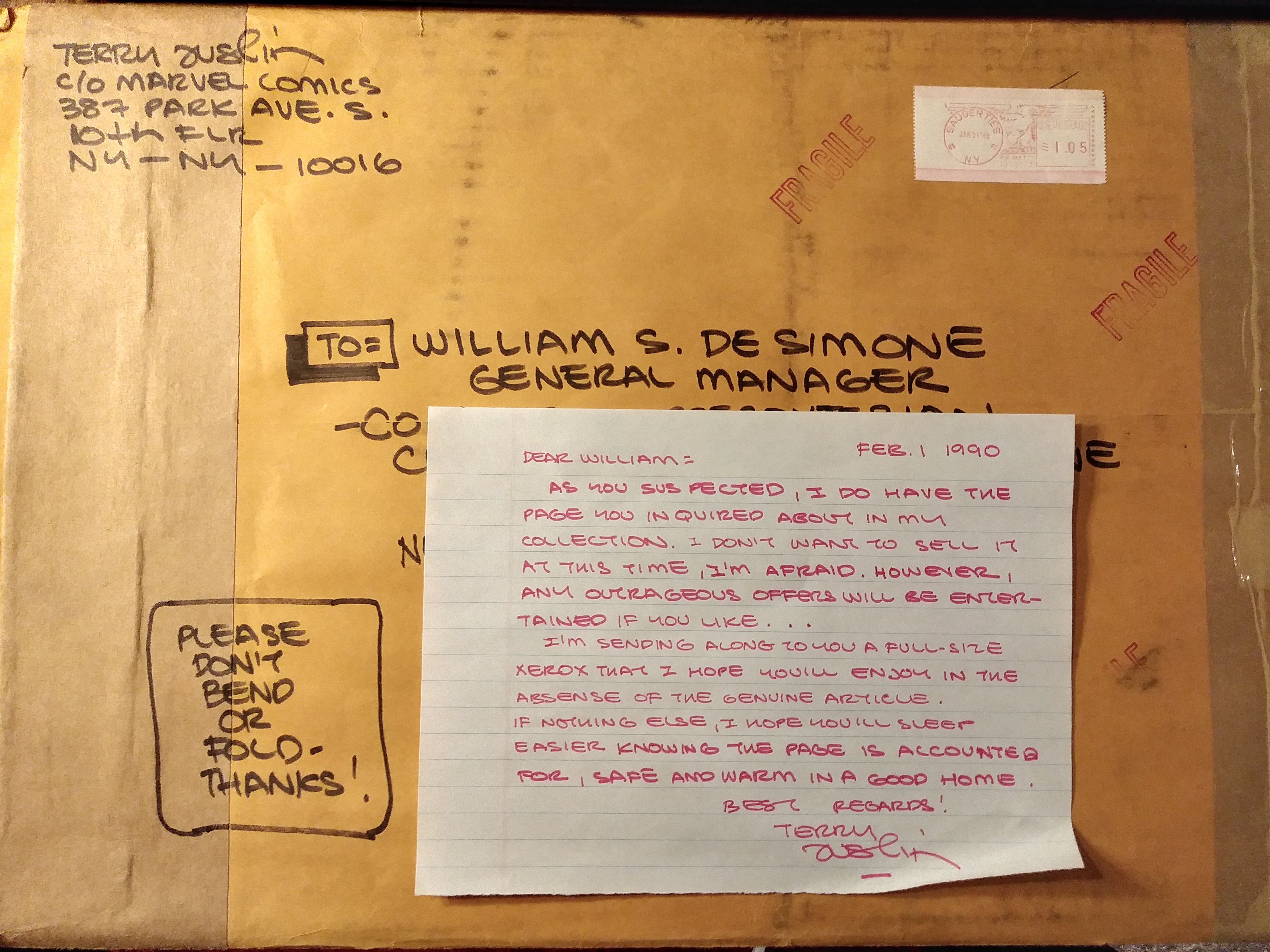
Inside was a full-size copy of the page and the note you see in the picture.
Not quite the same as the original art, but still cool — and still on my wall:
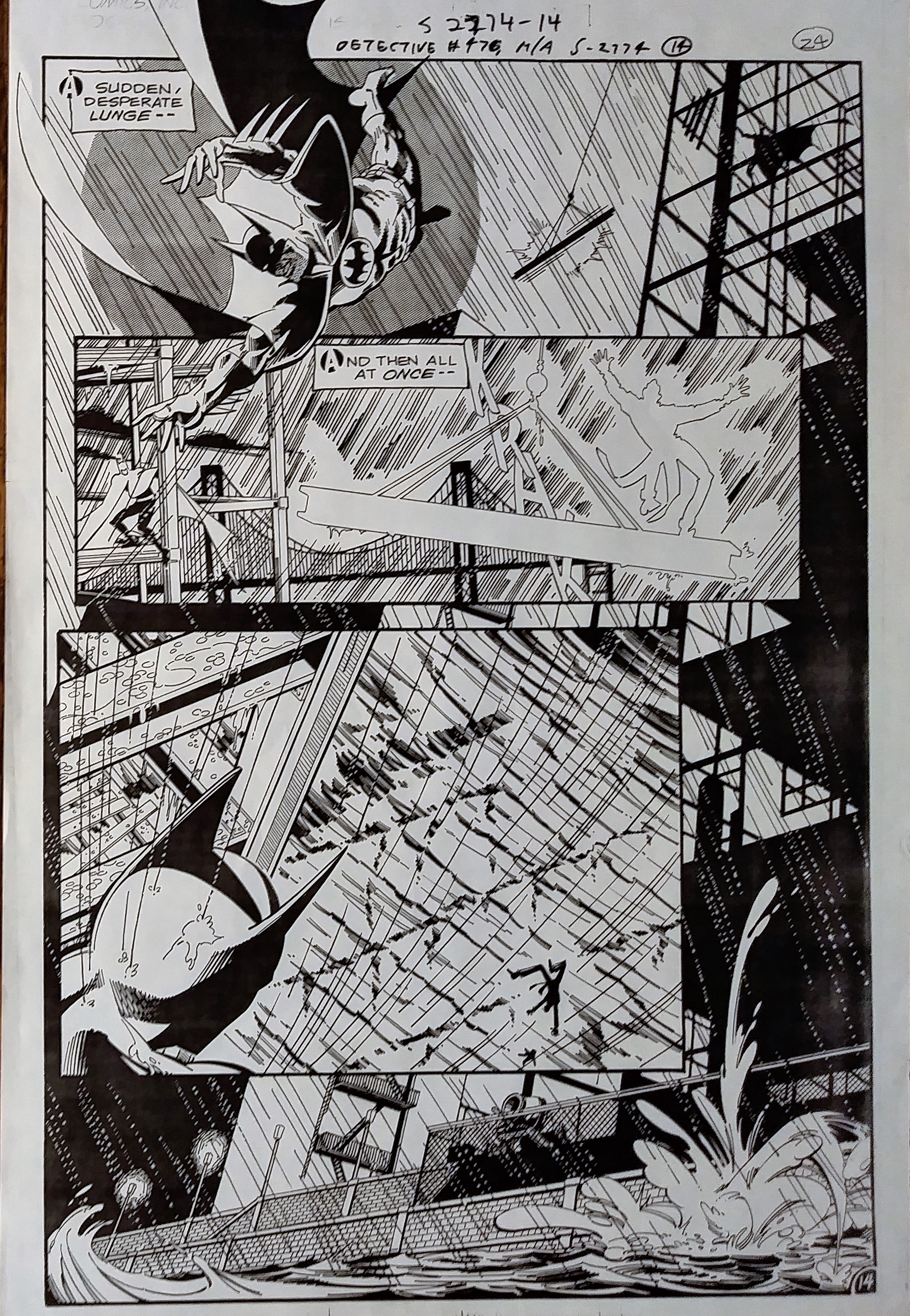
MORE
— For the MARSHALL ROGERS Index of stories and tributes, click here.

February 10, 2018
Some of the greatest Batman stories ever told and they still hold up today. Thanks for the post and I am jealous!!! Just one question of a page that has always bothered me. I think it was the final page that he did of Batman. He is swinging and part of the panel is obscured ( I think that’s the best way to describe it) with a X that is “centered” by a circle. The dialog boxes say, “In the dawning of a new day…he is gone!” I could never figure out why it was done that way.
February 10, 2018
This is a great anecdote bearing on a magnificent Rogers page. Thank you!
February 11, 2018
Fantastic story. And a fantastic page of course. So glad both it (and its copy) have a good home.
February 12, 2018
Can we assume the Xerox copy was done on Marvel equipment? What other great artwork was on that copy machine?
February 24, 2018
What a class act. Terry Austin’s generosity always amazes me!
June 12, 2018
I have to ask (and I’m not trying to be derogatory) but why did Rogers’ art change later on? By the time you get to ‘Siege’ from ‘Legends Of the Dark Knight’ in 2000, and ‘Batman: Dark Detective’ from 2006, also with Steve Englehart and Terry Austin inking (the same team as did those Detective comics), the artwork is very different, almost an indy style. What happened to make it so different?
August 23, 2019
It’s just an evolution of style. Keep in mind there was a gap of over 20 years between the Detective Comics stories in the late 1970s and the stories you refer to in Legends of the Dark Knight and Dark Detective (going on 30 years for the Dark Detective work). Another example would be Michael Golden’s recent style versus his 1970s Batman work collected in his Legends of the Dark Knight volume, or his Micronauts work from the 1970s. Or look at the change in Frank Miller’s work from his Daredevil days to his Sin City and Dark Knight Strikes Again style. Or consider the radical change in Bill Sienkiewicz’s style from Moon Knight to New Mutants to what he’s doing today. Nothing strange about it, but you’re right…Rogers’ work in Legends of the Dark Knight and Dark Detective is noticeably different from his older stuff in Detective Comics.
January 22, 2019
I met Terry Austin at a con in St Louis several years ago and got a page he inked that Marshall Rogers drew from “Doctor Strange”. The 1st panel has the good doctor over wartime London with barrage balloons peppering the sky. He and Clea then meet Sgt Fury & his British girlfriend in a pub. I asked him to sign it and, of course, he did but Terry did say something like, “Damn. Marshall covers the page and never leaves any space to sign. Wait…” He ended up signing on the wall of the pub booth like it was graffiti behind the characters.
January 23, 2019
That’s a great story! I love that.
January 24, 2019
This is really incredible stuff!
January 24, 2019
Whoa!
January 24, 2019
Very cool of Terry to provide that xerox. Heck, I’d be super happy to have a xerox of any of my favorite pages of original art any day!